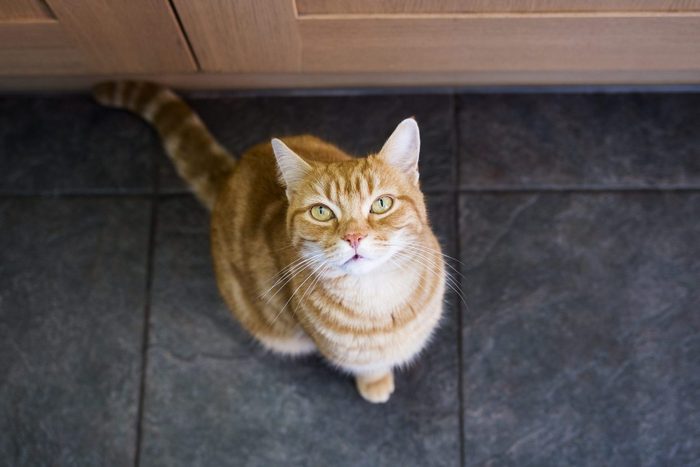
What is normal cat behavior?
Kids may say the darndest things, but it’s felines that really throw us for a loop with their odd cat behavior! From kneading on soft blankets to knocking things off tables to scratching our brand-new furniture, they tend to induce an equal amount of “awws!” and “oh no’s!” This cat behavior guide breaks down all the above and more, so keep reading. You’ll also want to read up on why cats love boxes, why cats hate water, and why cats purr. Check out this guide to cat body language to see what your feline is trying to tell you. Also, find out if cats get jealous.
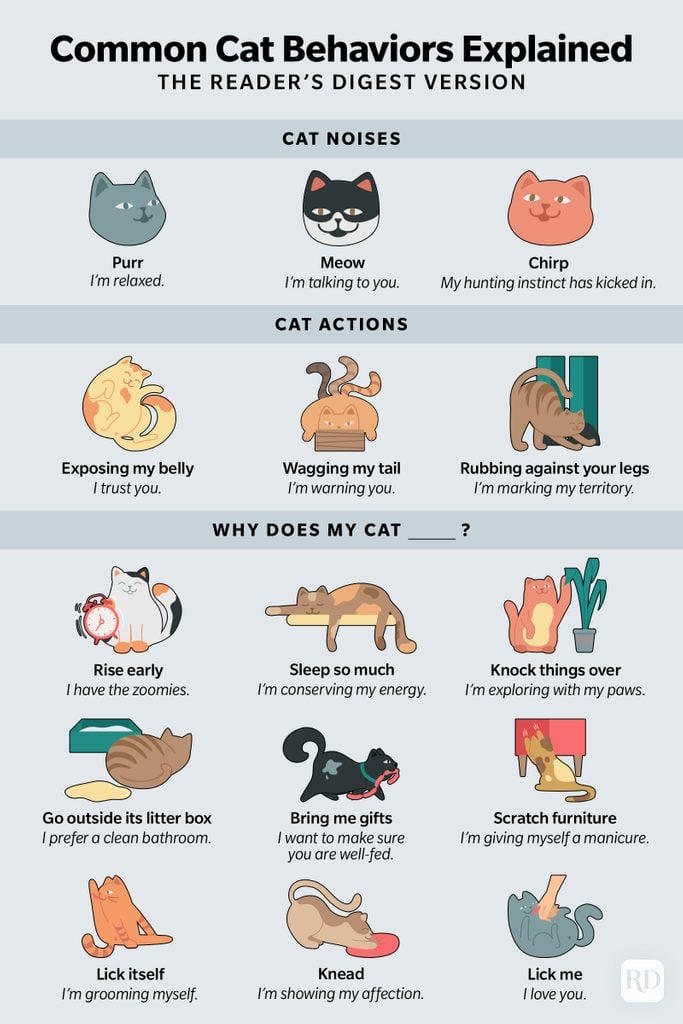
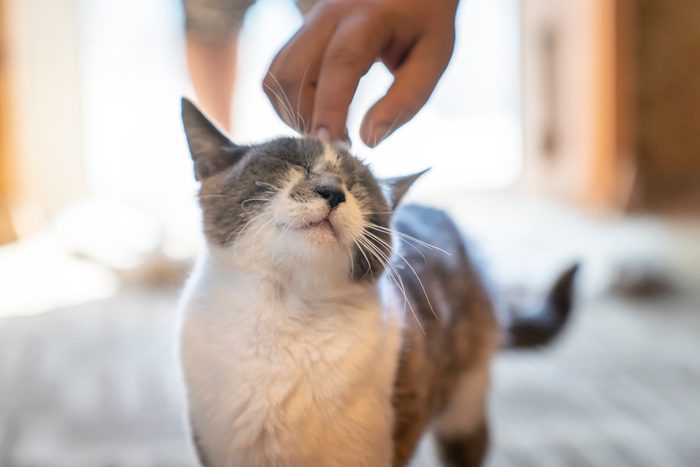
Purring
Purring is something that pretty much every single cat does, but interestingly we know less about why cats make this noise compared with other noises they’re famous for (like hissing or chirping). The reality is that purring has many different meanings.
“Cats often purr when they’re feeling relaxed, but they may also purr to self-soothe if they are feeling stressed or are injured,” says JoAnna Pendergrass, DVM, a veterinarian based in Atlanta. “When kittens are born, mama cats purr, creating a vibration to guide kittens to mom’s nipple to nurse. Cats will also purr to socialize with other cats and communicate with their owners that they want something.”
While you’re at it, also find out why scruffing a cat is a big no-no!
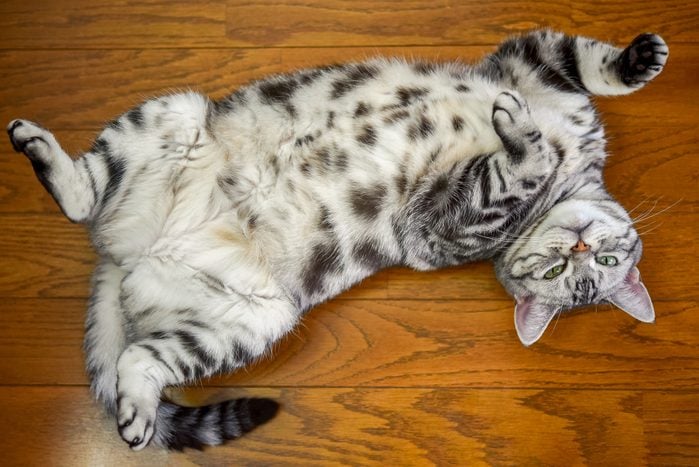
Showing its belly
Here’s an all-too-familiar scenario: Your sweet Max stretches out and shows off his fuzzy belly, which makes you want to reach out and give him a little pat or affectionate scritch. Only this is met with a rescinded offer—perhaps even a batting of the paw or a light bite. Strange cat behavior, indeed!
“When cats expose their bellies to us, they are saying they trust us. But when we take them up on this ‘offer’ by rubbing their bellies, they may retract it with a bite or a scratch, as it was only meant as a form of communication,” explains Sam Meisler, DVM, a veterinarian and founder of PetWellClinic.
If you establish even more trust you may be able to go in for the pets without reprimand, but be gentle and keep in mind this is a physical expression of trust more than it is an invitation. You may not recognize these subtle ways that your cat is showing affection.
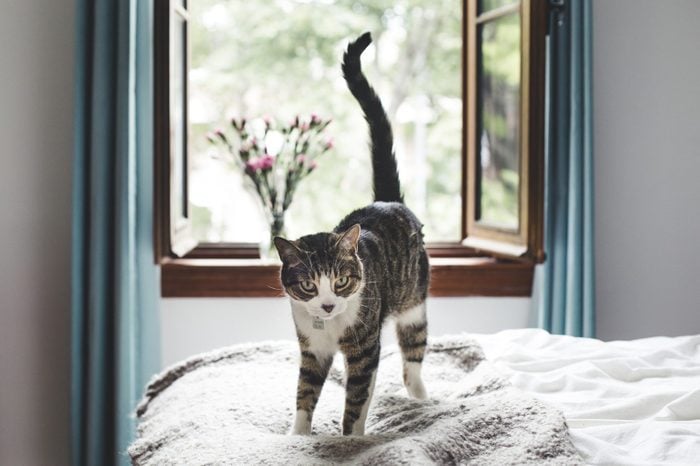
Wagging its tail
When a cat “wags” its tail, it’s not the same joyful response you get with a happy dog wag. In fact, it may mean the opposite.
“A cat tail wag can be more of a warning,” notes Evelyn Kass, DVM, a veterinarian with Pet Nutrition Doctor. “The tail wag is a sign of heightened excitement, annoyance, or frustration. The thrashing tail generally means ‘stop what you are doing or I am going to get angry and might bite you.'” She adds that when the tip of the tail is wagging, it is often a sign your cat is ready to pounce on their favorite toy, or perhaps on your leg.
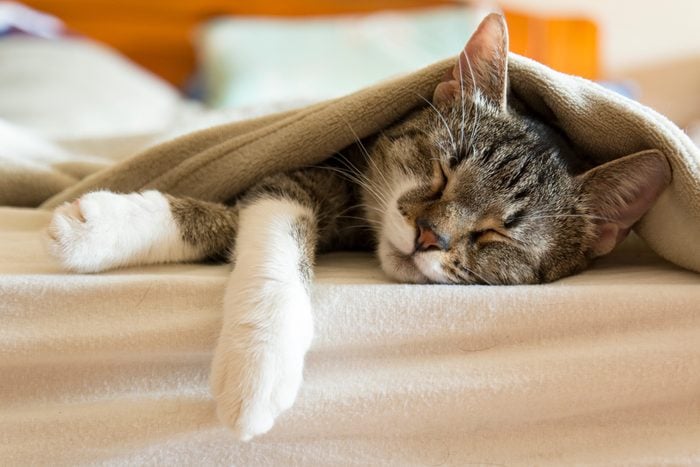
Napping
You might have noticed that your cat loves napping and seemingly sleeps all the time. “Generally, this trait has developed as an evolutionary advantage so that they can conserve energy for hunting. Of course, the domestic cat does not need to hunt, however the genetics are still there,” explains Dr. Meisler. “And they do like to sleep in warm areas. Keep in mind that a cat’s basal temperature is higher than ours by at least a couple of degrees.” That helps explain why cats love to sleep on you and to soak up the sun or sleep on warm surfaces, like your laptop.
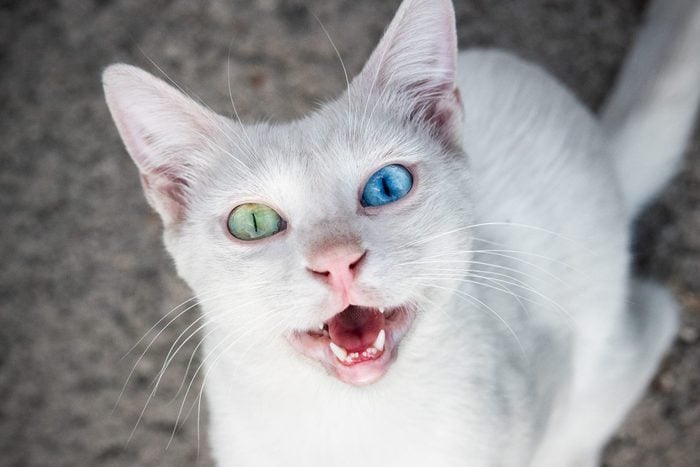
Chirping
In addition to purring and meowing, another common cat noise is chirping. You might find your cat chirping as it stares out the window from the perch at a bird or when it greets a fellow feline. A cat’s chirp tends to mean one of two things: Its hunting instincts are activated as it spies a bird, bug, mouse, or toy. Likely this type of chirping is accompanied by its tail twitching back and forth and dilated pupils. Or, a cat may also chirp when it’s excited to see someone, be it a fellow cat…or you. Figure out why your cat stares at you.

Rising early
In addition to being active at dusk, cats are also known for getting the zoomies at dawn. This is probably a time when you’d like to get a little more sleep before your alarm goes off, but this cat behavior comes naturally, and your feline doesn’t care what time your alarm is set for.
If you’re serious about curbing those early wake-up calls, start by installing blackout shades or blinds in your bedroom so the sun won’t rouse your cat. Then, stick to strict feeding times: once in the morning (but not right after you rise because then they’ll associate you getting out of bed with getting fed) and once shortly before you go to bed (to delay their hunger).
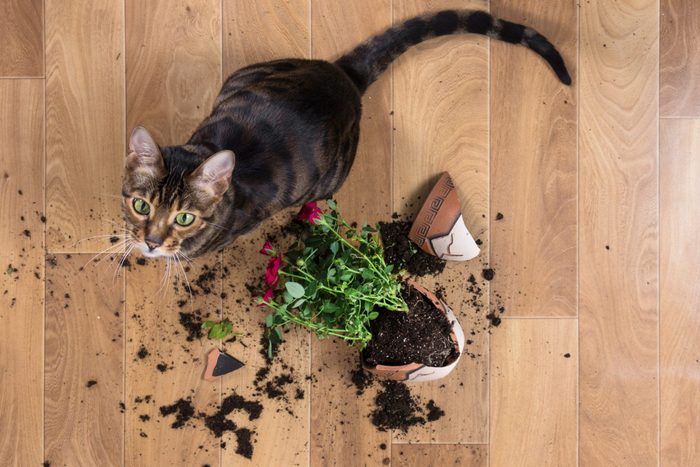
Knocking things over
If you’ve spent any amount of time with a cat, you’ve likely seen them bat at something on a table until it falls off. Maybe it’s a drinking glass or perhaps it’s your phone. Though somewhat hilarious—and perhaps maddening—this is perfectly normal cat behavior. Dr. Kass says there are many theories about this, which include everything from boredom to attention-seeking to hunting to simply being playful.
“Cats are naturally curious, and while dogs explore their environment with their mouths, cats are more likely to explore by touching and pushing an object with their paws,” says Dr. Kass. “They respond to the outcomes too. If something rolls, it may become prey ‘running away’ and they will chase. If you suddenly stop what you’re doing to run to your cat, there is a reward that can be tested over and over and over again.”
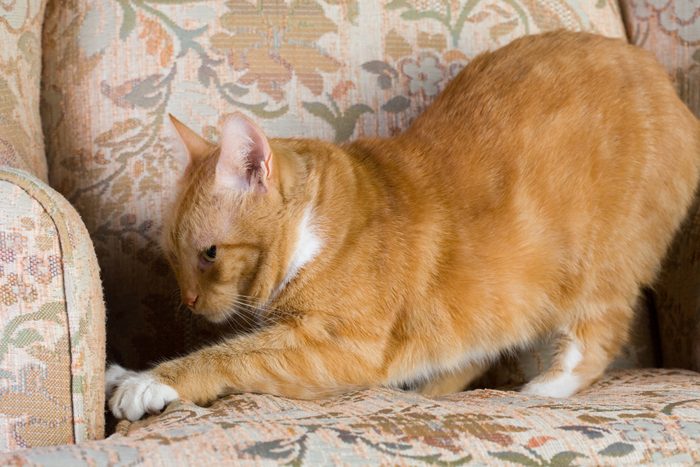
Scratching furniture
Just like you clip and file your nails so they don’t interfere with typing or other daily activities, cats must maintain their claws. Scratching—which is a deeply ingrained behavior in cats—is one way they do so.
There are also some other explanations as to why cats scratch. One is that they’re marking their territory. Cats have scent glands on their paws, and releasing the odor essentially allows them to “mark” objects as their own. Other reasons include releasing energy or excitement, and simply because scratching is fun and feels good.
The best solution to keeping your cat from scratching your furniture is to give them something even better to scratch on, like a pad or cat tower. Rub it with a little catnip and give them a treat whenever they use it to encourage the behavior. You can also invest in some cat-proof furniture that actually withstands all the scratching.
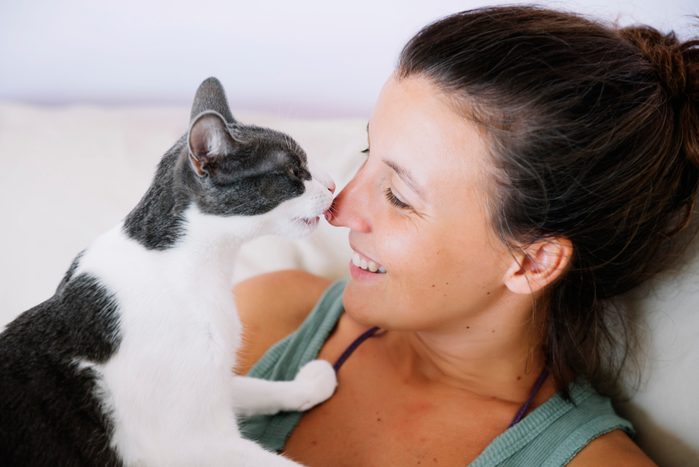
Licking you
Another cat behavior you may have noticed is your pet licking you with its rough tongue. They do this for a few reasons, notes Dr. Pendergrass.
“A cat will lick their humans to show care and affection. When your cat licks you, they are creating a special social bond with you,” she says. “This licking behavior stems from kittenhood, when a mama cat licks her kittens to groom and show affection.” Read on to find out if cats like kisses and other things to keep in mind before giving your fluffball a smooch.
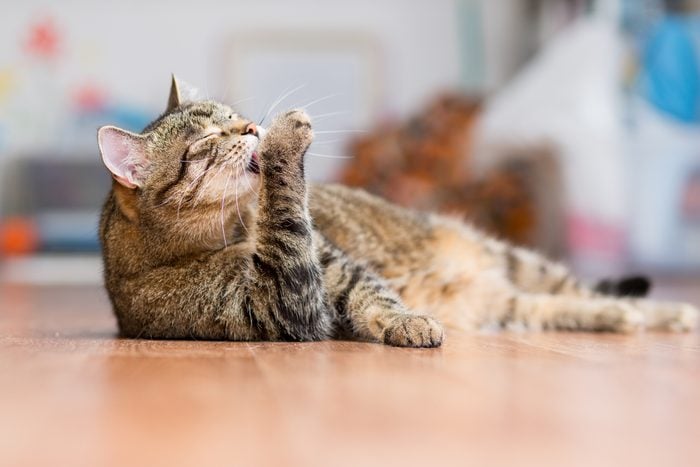
Licking itself
Along with licking you, cats tend to lick themselves—a lot! This is because they’re self-cleaning creatures, and their grooming habits are quite impressive. Cats are born with the essential grooming tools: paws, a rough, barbed tongue, and saliva. This means you don’t need to worry about routine baths and grooming in the same way you do for a dog. Only in rare cases do cats need a bath. If you find yourself in that predicament, here’s how to do it without getting scratched.
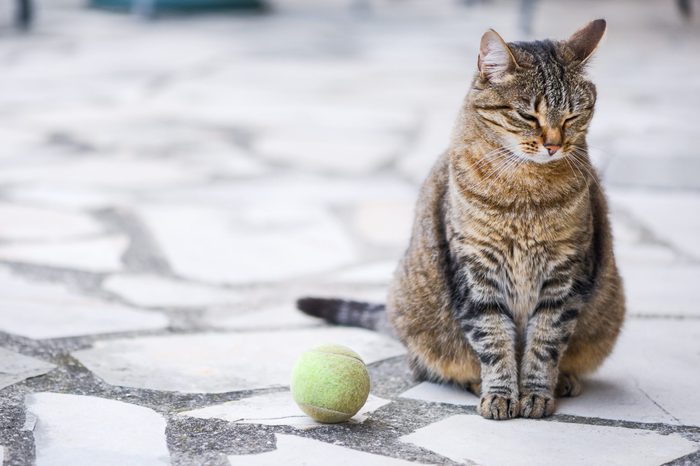
Bringing dead animals (or toys)
You’re sitting there minding your own business, and here comes your kitty making all sorts of weird noises and carrying an object in her mouth. If you’re lucky, it’s one of her favorite toys, but cats are also known to bring their humans dead bugs, rodents, and birds.
“Your cat may bring you a prey item—such as a toy or mouse—presenting it to you as a gift,” says Dr. Meisler. “This is your cat saying you are part of their pack and they want to make sure you are well fed.”
Other reasons they do this could include trying to return the feeding favor for keeping their kibble bowls full, imitating what their mama cats did for them, or giving you their catch so that you can store it for later.
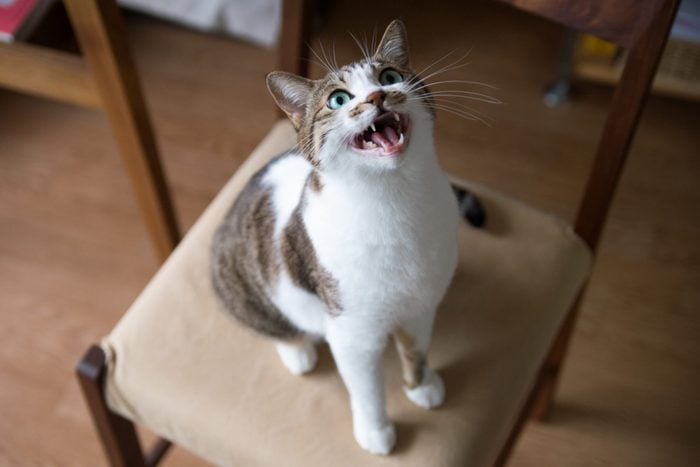
Meowing
Scientists have identified more than a dozen different meows that cats make, each with its own meaning. In general, kittens use meows to communicate with their moms, but grown cats employ them solely to communicate with humans. Cats also use hisses, growls, squeals, and other sounds to talk to each other. More perceptive owners can probably tell a cat’s “I’m hungry” meow from its “I’m bored,” or discern “I’m hurt” from “I’m scared.”
Some cat breeds are chattier than others, but if your cat goes from not-that-frequent to frequent talking, it could be a sign that something’s off. A vet visit can help you figure out the issue.
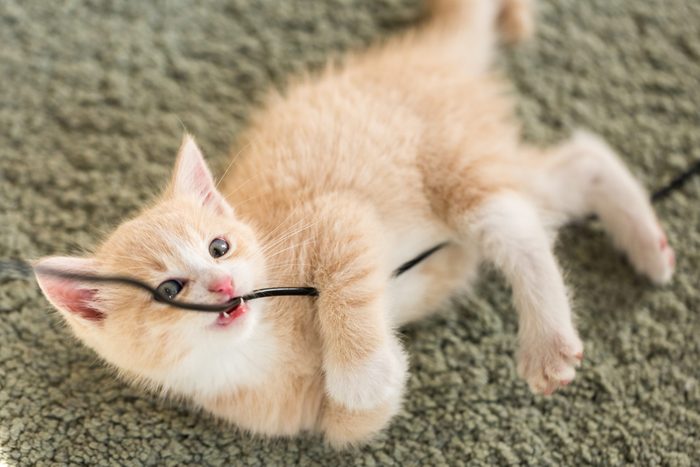
Chewing cords
Cats are playful creatures, and they’re especially drawn to things like ribbon, string, and cords. It’s not that they’re trying to be destructive or dangerous—it’s just that the cords are so accessible. Stow away the ones you’re not using, and cover the remainder in cord covers (you can find these at pet stores). You can also try applying bitter apple spray on cords, but dab it on sparingly, since consuming too much of the essential oils in it can make cats sick.
If your cat persists in chewing cords even after you apply the bitter apple, take him or her to the vet to rule out any dental problems.
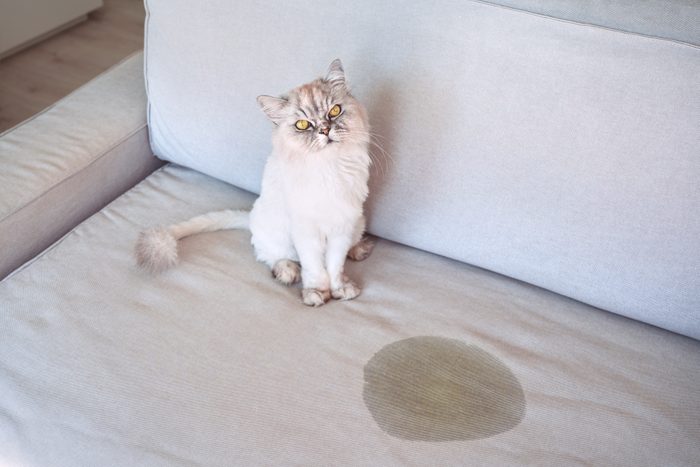
Going outside the litterbox
Cats actually prefer using litter boxes and are wired from kittenhood to “cover” their pee and poop, so when they do go outside the litter box, it’s a sign that something isn’t quite right. It may be tempting to learn how to stop your cat from peeing on the carpet altogether, but the problem will continue to persist if the underlying causes are not looked at.
It could be something as simple as them not liking the location of the box or the type of litter you use. Or they may prefer it to be cleaner (just as we prefer to use a clean bathroom).
Sometimes, a cat going outside the litter box signals a medical issue, such as a urinary tract infection (UTI). Your veterinarian can take a sample of their urine to determine if there’s an issue that needs to be addressed. Behavioral issues are another common reason cats don’t use the litter box. This might be the result of feeling territorial with other cats or not being as mentally/physically stimulated as they’d prefer.
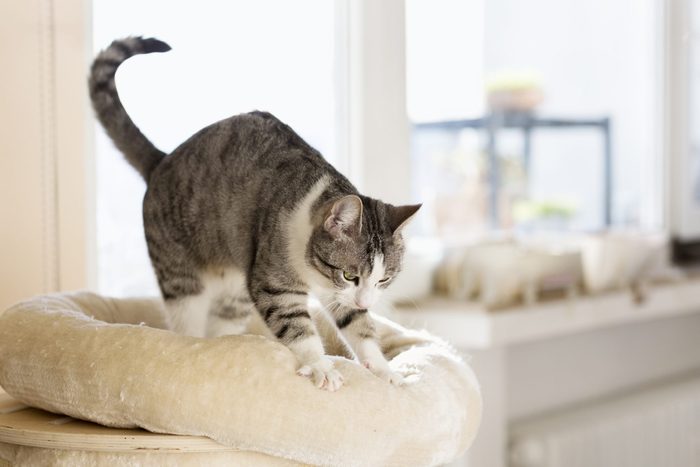
Kneading
Cat kneading goes by so many names: making biscuits, playing the piano, mashing potatoes, sleepy marching. However you refer to it, this cat behavior is downright adorable! There’s a reason cats do this, and it’s not just to be extra cute.
“This behavior is all about love and comfort,” Dr. Pendergrass says. For example, a cat will knead its owner to show affection, or knead a blanket to create that perfect comfy spot to settle in for a nap. Kneading is also a self-soothing behavior for anxious kitties.
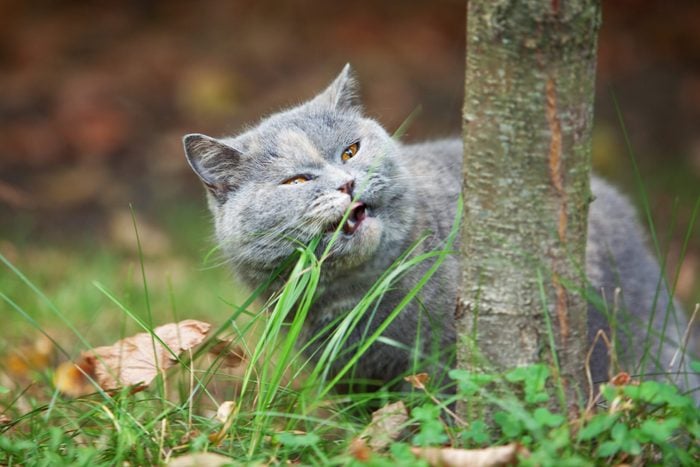
Eating grass
You feed your cat all the yummy kibble in the world, so what’s up with it eating grass? The truth is that we don’t understand it completely (the same goes for dogs eating grass), but experts have some theories. One is that they’re doing it to soothe their tummy, which can help with gastrointestinal upset or even help them with hairballs. It could also be a way for them to get certain nutrients they don’t have in their diet, or simply because it’s a tasty snack.
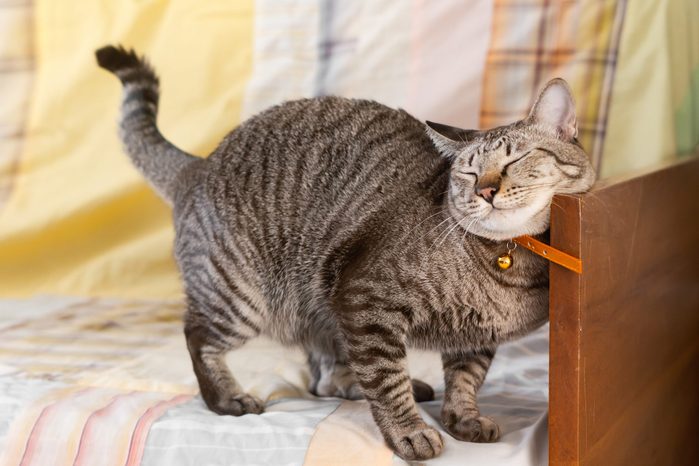
Rubbing
This is one of those cat behaviors that every cat parent has seen a million times but perhaps isn’t quite sure what it means. Cats often rub against objects in your home, but they’ll also rub against you. What does this mean?
They’re marking their territory, Dr. Kass says, and that includes you. “Cats have scent glands on their face that deposit unique identifying odors on the object they rub against. When they rub against you they are affirming that you are part of their family.” How cute is that?
Sources:
- JoAnna Pendergrass, DVM, veterinarian based in Atlanta
- Sam Meisler, DVM, veterinarian and founder of PetWellClinic
- Evelyn Kass, DVM, veterinarian with Pet Nutrition Doctor
